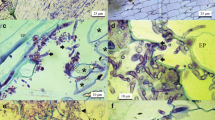Abstract
When tomato plants resistant toVerticillium albo-atrum become infected with this fungus the parasite grows very little in the stem. The stem, however, responds by producing many tyloses. In susceptible tomato plants in which the parasite is more abundant few tyloses occur, but after some weeks when the parasite begins to disappear from the lower parts of the shoots, vessels with tyloses increase in number. Severity of disease can be altered by treating plants with growth regulating substances.
These changes are usually accompanied by alterations in numbers of vessels with hyphae and tyloses in the stems in such a way, that an increase in number of vessels with hyphae is accompanied by a decrease in number of vessels with tyloses, and vice versa.
Extracts and diffusates from healthy susceptible plants affect germination of conidia and germ tube growth in the same way as those from resistant plants; some evidence was obtained which suggests that after infection, fungitoxic substances appear in resistant but not in susceptible plants.
Samenvatting
Als tegenVerticillium albo-atrum resistente tomateplanten met deze schimmel geïnfecteerd worden, ontwikkelt de parasiet zich slechts in geringen mate in de stengel. De stengel reageert hierop met de vorming van veel thyllen.
Bij vatbare planten, waarin de schimmel sterker is verbreid, ontstaan weinig thyllen, maar enkele weken na de infectie, op het tijdstip waarop de hoeveelheid in het onderste deel van de spruit begint af te nemen, neemt het aantal vaten met thyllen toe.
De mate van aantasting kan beïnvloed worden door de planten met groeiregulatoren te behandelen. Dergelijke veranderingen gaan gewoonlijk geppard met veranderingen in het aantal vaten met hyfen en thyllen, in die zin dat een toename van het aantal vaten met hyfen samengaat met een afname in het aantal vaten met thyllen, en vice versa. Extracten en diffusaten van gezonde vatbare planten, beinvloeden de kieming van conidien en de groei van kiemhyfen op soortgelijke wijze als die afkomstig van resistente planten. Bepaalde gegevens suggereren echter dat na infectie wel in resistente, doch niet in vatbare planten fungitoxische stoffen worden gevormd.
Similar content being viewed by others
References
Chambers, H. and Corden, M. E., 1963. Semeiography of Fusarium wilt of tomato. Phytopathology 53: 1006–1010.
Matta, A. and Dimond, A. E., 1963. Symptoms of Fusarium wilt in relation to quantity of fungus and enzyme activity in tomato stems. Phytopathology 53: 574–578.
McClure, T. T., 1950. Anatomical aspects of Fusarium wilt of sweet potatoes. Phytopathology 40: 769–775.
Talboys, P. W., 1958. Association of tyloses and hyperplasia of xylem withvascular invasion of the hop with Verticillium albo-atrum. Trans. Brit. mycol. Soc. 41: 249–260.
Author information
Authors and Affiliations
Rights and permissions
About this article
Cite this article
Sinha, A.K., Wood, R.K.S. Resistance to vascular wilt parasites. Netherlands Journal of Plant Pathology 74 (Suppl 1), 149–156 (1968). https://doi.org/10.1007/BF01977524
Issue Date:
DOI: https://doi.org/10.1007/BF01977524




